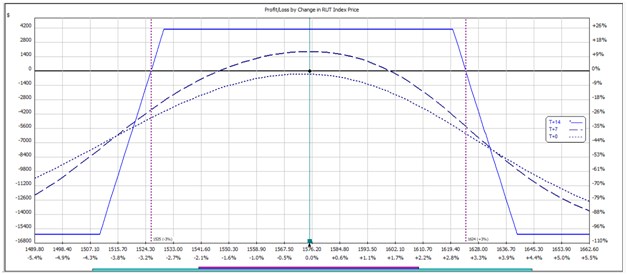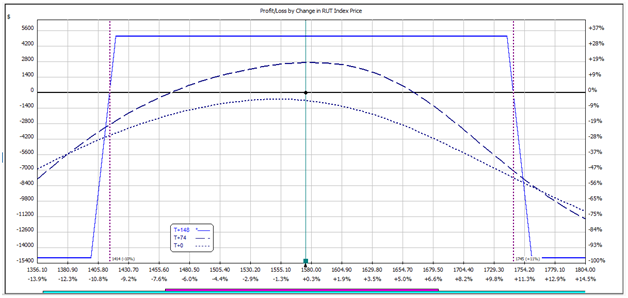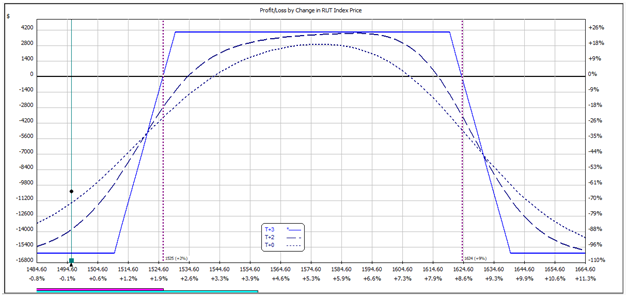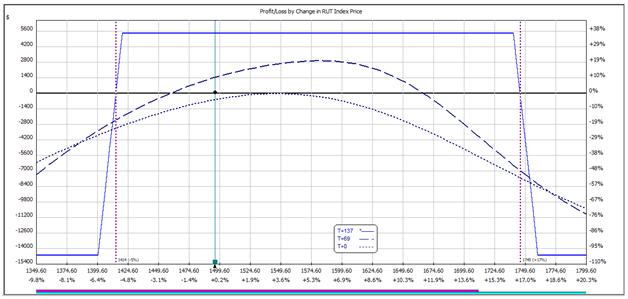
Ever seen those ads about making 5% per month with Iron Condors? It’s certainly possible, but you would have to be a bit naïve to think making a 60% per year return is simple. Most professional money managers cannot achieve those returns, so why would a retail trader be able to achieve it?
Unfortunately, most people are being misled when it comes to Iron Condors. The potential gains are certainly amazing, but the risks are high as well.
Anyone trying to achieve a 5% per month return is likely taking on a lot more risk than they realize.
I’ve heard this story from beginner traders too many times to remember – “everything was going great, I was making loads of money with my weekly condors, and then WHAM, I lost 6 months’ worth of gains in 1 week”.
Those are the risks when it comes to Iron Condors, and the shorter the timeframe you are trading, the more likely you are to suffer a catastrophic loss at some point.
Early February was a prime example. Anyone trading weekly Iron Condor would have been killed.
Short-term Iron Condors have a huge amount of Gamma risk. Gamma risk is effectively price risk.
Trades with negative gamma will suffer from a big move in the underlying stock. Iron Condors as you might have guessed, are short gamma.
Short-term Iron Condors have a lot more negative gamma (or price risk) than longer term Iron Condors.
Let’s evaluate two theoretical examples set up just before the recent selloff.
SHORT-TERM IRON CONDOR
This short term Condor could have been set up towards the close on Thursday February 1 st when RUT was trading at 1575.


LONG-TERM IRON CONDOR
This longer-term Condor could have also been set up late on Thursday the 1 st of February. Notice that between the two examples, Delta and Vega and almost the same, but the longer-term trade has almost no Gamma.
The trade off is lower Theta as Gamma and Theta go hand in hand.


ONE WEEK LATER
Let’s fast forward to the close of trading on Monday February 12 th and RUT has dropped nearly 100 points to 1496.
The short-term Condor has been well and truly crushed and is down over $10,0000.
In comparison, the long-term Iron Condor is actually in profit to the tune of $100!
SHORT-TERM CONDOR

LONG-TERM CONDOR

I hope you enjoyed this case study, if you want to learn more about how to manage Iron Condors, join me for a live training session coming up soon.
Gavin McMaster has a Masters in Applied Finance and Investment. He specializes in income trading using options, is very conservative in his style and believes patience in waiting for the best setups is the key to successful trading. He likes to focus on short volatility strategies. Gavin has written 5 books on options trading, 3 of which were bestsellers. He launched Options Trading IQ in 2010 to teach people how to trade options and eliminate all the Bullsh*t that’s out there. You can follow Gavin on Twitter.
What Is SteadyOptions?
Full Trading Plan
Complete Portfolio Approach
Diversified Options Strategies
Exclusive Community Forum
Steady And Consistent Gains
High Quality Education
Risk Management, Portfolio Size
Performance based on real fills
Non-directional Options Strategies
10-15 trade Ideas Per Month
Targets 5-7% Monthly Net Return
Recent Articles
Articles
Pricing Models and Volatility Problems
Most traders are aware of the volatility-related problem with the best-known option pricing model, Black-Scholes. The assumption under this model is that volatility remains constant over the entire remaining life of the option.
By Michael C. Thomsett, August 16

- Added byMichael C. Thomsett
- August 16
Option Arbitrage Risks
Options traders dealing in arbitrage might not appreciate the forms of risk they face. The typical arbitrage position is found in synthetic long or short stock. In these positions, the combined options act exactly like the underlying. This creates the arbitrage.
By Michael C. Thomsett, August 7

- Added byMichael C. Thomsett
- August 7
Why Haven't You Started Investing Yet?
You are probably aware that investment opportunities are great for building wealth. Whether you opt for stocks and shares, precious metals, forex trading, or something else besides, you could afford yourself financial freedom. But if you haven't dipped your toes into the world of investing yet, we have to ask ourselves why.
By Kim, August 7

- Added byKim
- August 7
Historical Drawdowns for Global Equity Portfolios
Globally diversified equity portfolios typically hold thousands of stocks across dozens of countries. This degree of diversification minimizes the risk of a single company, country, or sector. Because of this diversification, investors should be cautious about confusing temporary declines with permanent loss of capital like with single stocks.
By Jesse, August 6

- Added byJesse
- August 6
Types of Volatility
Are most options traders aware of five different types of volatility? Probably not. Most only deal with two types, historical and implied. All five types (historical, implied, future, forecast and seasonal), deserve some explanation and study.
By Michael C. Thomsett, August 1

- Added byMichael C. Thomsett
- August 1
The Performance Gap Between Large Growth and Small Value Stocks
Academic research suggests there are differences in expected returns among stocks over the long-term. Small companies with low fundamental valuations (Small Cap Value) have higher expected returns than big companies with high valuations (Large Cap Growth).
By Jesse, July 21

- Added byJesse
- July 21
How New Traders Can Use Trade Psychology To Succeed
People have been trying to figure out just what makes humans tick for hundreds of years. In some respects, we’ve come a long way, in others, we’ve barely scratched the surface. Like it or not, many industries take advantage of this knowledge to influence our behaviour and buying patterns.

- Added byKim
- July 21
A Reliable Reversal Signal
Options traders struggle constantly with the quest for reliable
By Michael C. Thomsett, July 20

- Added byMichael C. Thomsett
- July 20
Premium at Risk
Should options traders consider “premium at risk” when entering strategies? Most traders focus on calculated maximum profit or loss and breakeven price levels. But inefficiencies in option behavior, especially when close to expiration, make these basic calculations limited in value, and at times misleading.
By Michael C. Thomsett, July 13

- Added byMichael C. Thomsett
- July 13
Diversified Leveraged Anchor Performance
In our continued efforts to improve the Anchor strategy, in April of this year we began tracking a Diversified Leveraged Anchor strategy, under the theory that, over time, a diversified portfolio performs better than an undiversified portfolio in numerous metrics. Not only does overall performance tend to increase, but volatility and drawdowns tend to decrease:
Thursday, February 6, 2020